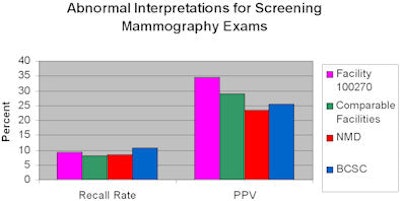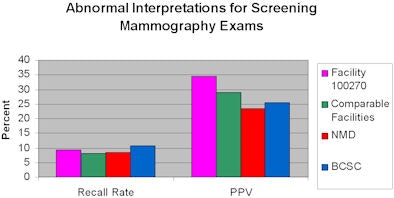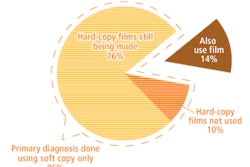
The American College of Radiology (ACR) is establishing a National Mammography Database, a national registry of comprehensive mammography data designed to help breast imaging facilities improve their quality of care. The database will be launched officially in July 2009.
The National Mammography Database will enable hospitals and imaging centers to compare their performance and patient outcomes against similar practices, as well as national and regional benchmarks. The ACR of Reston, VA, began a drive to recruit breast imaging facilities to join the database effort at last month's Society of Breast Imaging (SBI) postgraduate course in Colorado Springs, CO.
Data will be securely transferred from each participating site to the ACR using a single Web-enabling command built into ACR-certified BI-RADS mammography reporting software. A number of software developers either already offer this functionality or plan to have it available by the time the database launches, according to Laura Coombs, Ph.D., the program's director.
Already offering the functionality are Mammography Reporting System of Seattle; PenRad Technologies of Minnetonka, MN; and Swearingen Software of Houston. Atirix Medical Systems of Minneapolis; GE Healthcare of Chalfont St. Giles, U.K.; and MagView of Burtonsville, MD, are expected to have reporting functionality available by July.
Participants in the program can upload their mammography audit data as frequently as they wish, or at a minimum of once every six months. The database will provide one-click access to national and regional benchmarking, and each participant can obtain semiannual comparative reports and graphic benchmark data. In addition to national comparisons, data from each facility will be analyzed with data received from other comparably sized facilities and with all facilities in the same geographic region.
 |
| Sample comparison of recall rate and positive predictive value (PPV) with comparably sized facilities and national averages. Image courtesy of Laura Coombs, Ph.D. |
The database will facilitate comparing practice processes and outcomes by providing cancer detection rates, types of cancers detected, false-positive rates, and positive predictive value rates, all collected in a standardized format. Tools also exist to improve breast cancer research, and patient and exam details can be analyzed, as well as the interpretive skills of radiologists.
"The National Mammography Database was created to be a source for objective information to assess practice patterns, to target specific areas for improvement, to measure progress, and to document quality of service," Coombs said. "It is designed to answer such critical questions as how a practice compares against comparable practices and quickly determine if processes and performance need to be improved."
The ACR will charge facilities an annual membership fee to gain access to the database, with fees based on a sliding scale according to the number of radiologists at a facility. Effective January 2010, the annual fee will be $500 for a facility with one to five radiologists, and up to $2,000 for facilities with more than 55 radiologists. The ACR is offering a charter member discount of 50% off through December 31, 2009.
"We've tried to make this very affordable," Coombs said. "The more facilities that join, the better and more representative the data will be."
Dr. Edward Sickles, professor emeritus of radiology and section chief of breast imaging at the University of California, San Francisco's Helen Diller Family Comprehensive Cancer Center, headed the ACR committee to oversee the development of the database.
In a telephone interview, Sickles told AuntMinnie.com that this is the ACR's second initiative. "The ACR tried to establish a national mammography registry about a decade ago, but it was too difficult for facilities to collect and submit the data in the format the ACR needed. With the proliferation of mammography reporting systems with Web-enabled functionality, it is now possible to have these vendors integrate standardized, automated data export functionality in a secure format," he explained.
The committee members represented a mix of academic hospitals, tertiary care hospitals, and freestanding imaging centers from geographic locations throughout the U.S., according to Sickles. They worked on the project with Coombs, a professional statistician, for approximately two years.
The functionality of the database was demonstrated for the first time at the SBI meeting. Information is available at www.nrdr.acr.org.
By Cynthia E. Keen
AuntMinnie.com staff writer
May 7, 2009
Related Reading
Breast imagers get savvy as healthcare reform looms, April 29, 2009
Outcomes data add accuracy to mammography interpretations, April 20, 2009
Mammography as an outpatient revenue generator? You bet, April 9, 2009
Exceeding 'excellent': How breast centers track quality, February 17, 2009
Breast centers can manage malpractice risk, January 13, 2009
Copyright © 2009 AuntMinnie.com



















